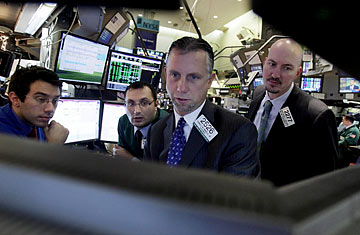
It's been a great year for many mutual fund investors. Standard & Poor's Equity Research reports that 165 equity mutual funds are up at least 47% through Oct. 31, or at least double the return of the S&P 500.
While investors in those funds should feel euphoric, S&P is quick to issue a warning to investors who might fall victim to those seductive returns. The S&P report, issued Friday, indicates that many of the best-performing funds relied on short-term strategies and paid little attention to the underlying fundamentals of the stocks in their portfolios, which could lead to a performance problem in 2010. "Using only a backward-looking approach to selecting funds [i.e., past performance] has significant flaws because it ignores the fundamentals of the stocks owned by the fund along with relevant risk and cost factors of the fund," the report said.
Of the 165 domestic equity funds that at least doubled the market's return, only 12% are ranked as S&P five-star funds. In fact, 19% are now ranked with a one- or two-star rating, effectively placing them in the bottom half of funds on overall attractiveness. "These funds have relatively weak fundamentals that contribute negatively to the ranking," S&P's analysts note in their report. The reasons cited for such low star rankings: many own overvalued or risky stocks, have managers with short tenures, have high costs or offer poor long-term performance.
The S&P research team cited Hotchkis & Wiley Mid-Cap Value Fund, Legg Mason Capital Management Opportunities Trust and Fidelity Select Automotive Portfolio as examples of funds that had eye-popping 2009 returns, but are currently ranked as two-star funds by the S&P.
The Hotchkis & Wiley Mid-Cap Value Fund is up 52% so far this year, making it the fifth-best performing mid-cap value fund this year, according to Morningstar. However, S&P believes the fund's "volatile longer-term performance should give investors cause for concern." It noted that the fund significantly lagged its peer average in 2007 and 2008, pushing it into the bottom quartile on a three- and five-year total return basis. Also, S&P analysts contend the fund's securities are currently overvalued and pose risk based on their growth and consistency when it comes to historical earnings and dividends. It also cited the fund's cost factors as contributing to the fund's weaker ranking.
However, Stan Majcher, principal and portfolio manager of the Hotchkis & Wiley Mid-Cap Value Fund, disagrees. Majcher noted that his fund has a strong long-term performance record, as Morningstar currently ranks it the third best performing mid-cap fund when it comes to annualized returns over the past 10 years, with an annualized return of 10.85%. He acknowledges the fund underperformed in 2007 and 2008, but doesn't think these periods should be considered in isolation.
Majcher says his fund's strategy is to seek out stocks that are wrongly considered risky or overvalued. "We screen for and invest in securities that are misunderstood," he says. "We'll tend to have stocks that look like they have poor characteristics, but when you dig a lot deeper, they don't." He said many of these companies have "temporary issues" that will go away and lead to higher stock performance. His portfolio trades at less than 10 times earnings, which is not overvalued, Majcher contends. "The portolio trades at less than 10 times earnings and the market trades significantly higher than that — usually 14 or 15 times."
He also noted that he's been managing the portfolio since 1999, which should wipe out concerns about "short tenures."
"We've been around for 10 years and this isn't the first time we've screened poorly," Majcher says, "but we have actually have good performance over the period."
On the positive side, S&P named the Pin Oak Aggressive Stock fund as an example of a fund that performed strongly in 2009 and remains a good bet for 2010. The fund is up 71% so far in 2009 and "scored positively on S&P Fair Value and for its low-cost factors-components in the S&P fund ranking." The fund's portfolio manager, Mark Oelschlager, says his fund always seeks out stocks based on valuation and long-term investment. His fund started moving into cyclical stocks and increasing risk late last year at a time when "fear was rampant" in the market because "it was mispriced," he says. "We pay a lot of attention to valuation," adds Oelschlager. "This paid off this year and we think it will pay off next year as well."
Oelschlager also noted that his firm keeps a low expense ratio, keeps trading costs down and manages its portfolio in a tax-efficient manner.
Such factors are the ones to consider, says S&P analyst Todd Rosenbluth, along with fundamentals, risk, performance track record and cost factors. "Before making a selection, make sure to look at not just the gains the fund may have achieved this year, but also aim to understand the fundamentals of its performance, risk and cost factors," he said, in a statement. "This year's top fund could repeat their success in 2010 or be next year's bottom funds."
